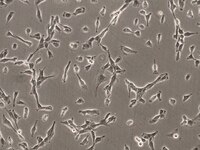SCC440 Sigma-AldrichSK-MEL-147 Human Melanoma Cell Line
The SK-MEL-147 cell line expresses PMEL and MelanA proteins, two common melanoma markers. PMEL has been implicated in poor immune cell infiltration, and may be a relevant target for drug therapy due to its limited expression in normal cell phenotypes.
More>> The SK-MEL-147 cell line expresses PMEL and MelanA proteins, two common melanoma markers. PMEL has been implicated in poor immune cell infiltration, and may be a relevant target for drug therapy due to its limited expression in normal cell phenotypes. Less<<Recommended Products
Overview
| Replacement Information |
|---|
| References |
|---|
| Product Information | |
|---|---|
| Components |
|
| Quality Level | MQ100 |
| Biological Information | |
|---|---|
| Host | Human |
| Cell Line Type |
|
| Physicochemical Information |
|---|
| Dimensions |
|---|
| Materials Information |
|---|
| Toxicological Information |
|---|
| Safety Information according to GHS |
|---|
| Safety Information |
|---|
| Packaging Information | |
|---|---|
| Material Size | ≥1X10⁶ cells/vial |
| Transport Information |
|---|
| Supplemental Information |
|---|
| Specifications |
|---|
| Global Trade Item Number | |
|---|---|
| Catalog Number | GTIN |
| SCC440 | 04065270293756 |











